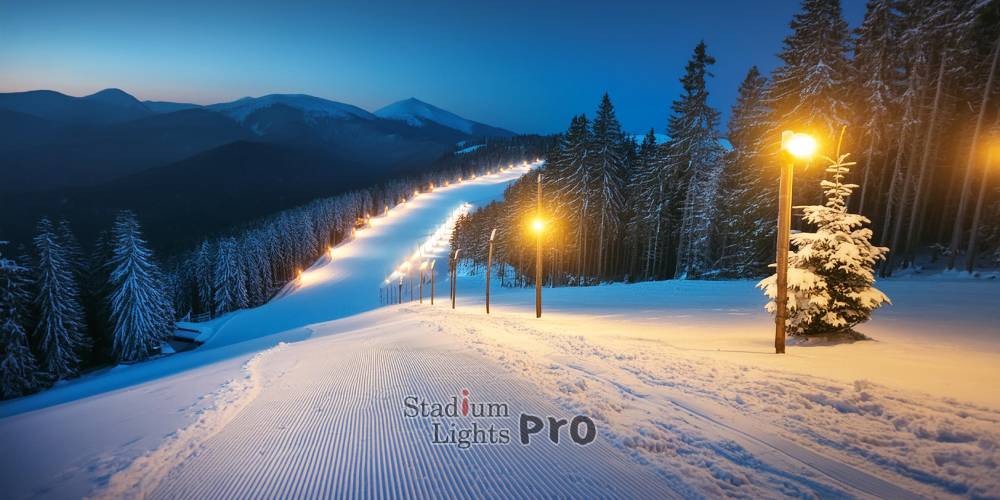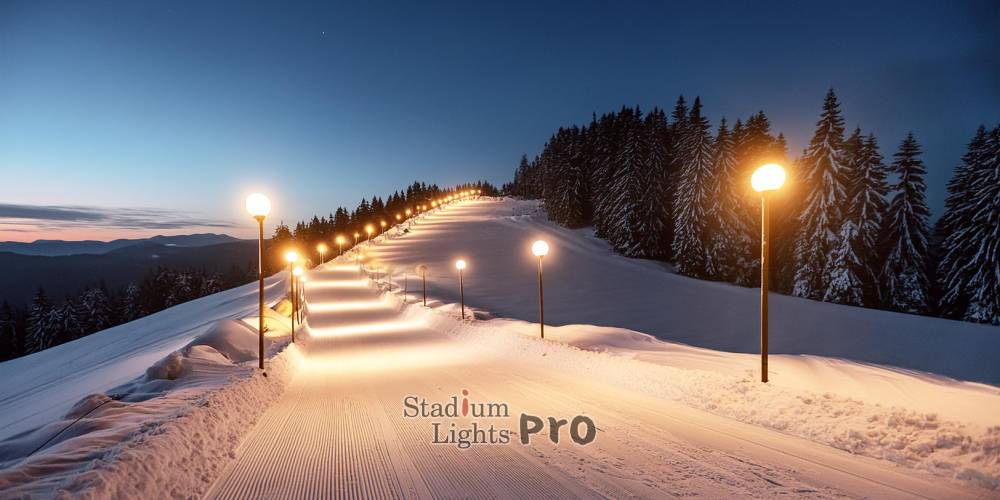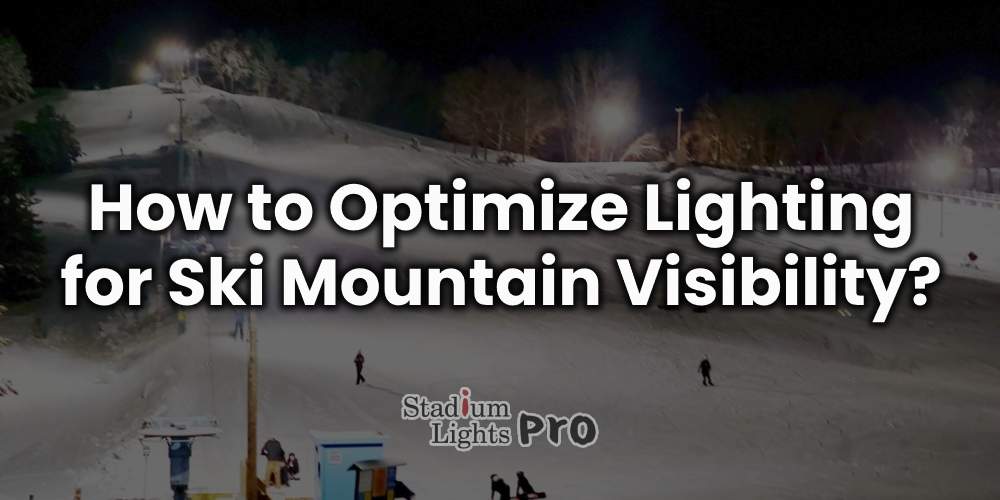As daylight dwindles and darkness sets in, the significance of effective illumination becomes even more pronounced. Beyond merely extending skiing hours, well-designed lighting systems significantly enhance visibility, thereby minimizing the risks associated with navigating through challenging terrains in low-light conditions.
Safety stands at the forefront of concerns for both skiers and resort operators alike. Adequate lighting not only illuminates potential hazards such as bumps, icy patches, or sudden drops but also facilitates clearer communication of trail markings and signage. This clarity of visibility enables skiers to react swiftly and confidently, reducing the likelihood of accidents and injuries. Moreover, enhanced visibility fosters a sense of reassurance and confidence among skiers, contributing to an overall positive and enjoyable skiing experience. Whether it’s carving down groomed slopes or navigating through tree-lined trails, the ability to discern terrain features and fellow skiers is paramount to a fulfilling day on the mountain. Therefore, investing in optimized lighting infrastructure is not just a matter of convenience but a fundamental aspect of ensuring the safety and enjoyment of all who venture onto the slopes.
Table of Contents
ToggleUnderstanding Lighting Needs
Different lighting requirements for various areas of the ski mountain
The lighting needs across a ski mountain vary depending on the specific area and its intended use. Slopes, trails, and the base area each have distinct requirements to ensure optimal visibility and safety for skiers. Slopes, where most skiing activities take place, typically require bright and evenly distributed lighting to illuminate the entire run. This ensures that skiers can navigate safely and confidently, even in low-light conditions or at night. Trails, especially those winding through forests or challenging terrain, may require additional lighting to highlight potential obstacles and hazards. In contrast, the base area may require softer lighting for ambiance and navigation around facilities such as lodges, restaurants, and parking lots.
Factors affecting visibility
Several factors can affect visibility on a ski mountain, necessitating careful consideration when planning lighting solutions. Weather conditions, such as fog, snowfall, or low clouds, can dramatically reduce visibility, making it challenging for skiers to see obstacles or other skiers. Similarly, the time of day plays a crucial role, with lighting needs shifting as daylight fades into dusk and eventually darkness. Understanding these factors is essential for designing lighting systems that can adapt to changing conditions and provide consistent visibility throughout the day and night. By accounting for these variables, ski resorts can ensure that their lighting infrastructure effectively enhances safety and enjoyment for skiers across all conditions.
Assessment of Current Lighting Infrastructure

Evaluate existing lighting systems
Before implementing any changes or upgrades, it’s essential to conduct a comprehensive evaluation of the current lighting infrastructure across the ski mountain. This evaluation should include an assessment of the type, placement, and condition of existing lighting fixtures. It’s crucial to determine whether the current systems adequately meet the lighting needs of skiers, considering factors such as brightness, coverage, and energy efficiency. Additionally, assessing the reliability and maintenance requirements of existing lighting systems can help identify areas for improvement.
Identify areas with poor visibility or inadequate lighting
Once the evaluation is complete, the next step is to identify specific areas across the ski mountain where visibility is compromised due to poor lighting or inadequate illumination. This may involve conducting on-site inspections during both daylight and nighttime hours to assess visibility levels and identify potential hazards. Common areas where poor visibility may be a concern include steep slopes, narrow trails, intersections, and areas with dense vegetation or obstacles.
By pinpointing these areas, ski resort operators can prioritize lighting upgrades or adjustments to improve visibility and enhance safety for skiers. This may involve installing additional lighting fixtures, adjusting the angle or direction of existing fixtures, or upgrading to more energy-efficient and effective lighting technologies. Additionally, addressing areas with poor visibility can contribute to a more enjoyable skiing experience for guests, as they can navigate the mountain with greater confidence and ease, regardless of lighting conditions.
Key Considerations for Optimal Lighting
Types of lighting fixtures suitable for ski mountain environments
Choosing the right type of lighting fixtures is crucial for ensuring optimal visibility and safety on a ski mountain. LED fixtures for ski slopes are often preferred for their energy efficiency, durability, and ability to provide bright, uniform illumination. Additionally, floodlights, spotlights, and area lights are commonly used to illuminate slopes, trails, and other key areas across the mountain. These fixtures can be strategically placed to provide adequate coverage while minimizing glare and light pollution.
Directionality and angle of light placement
The directionality and angle of light placement play a significant role in determining the effectiveness of lighting on a ski mountain. Lighting fixtures should be positioned to minimize shadows and ensure even illumination across slopes and trails. Angling lights downward can help prevent glare and ensure that the terrain is adequately lit for skiers to navigate safely. Additionally, directional lighting can be used to highlight specific features or hazards, such as moguls, jumps, or trail intersections.
Color temperature and brightness levels
The color temperature and brightness levels of lighting fixtures can impact visibility and the overall skiing experience. Optimal color temperature for ski mountain lighting is typically in the cool white range (4000-6000 Kelvin), which provides clear, crisp illumination without distorting colors or creating excessive glare. Brightness levels should be carefully calibrated to provide sufficient visibility without causing discomfort or visual fatigue for skiers. Dimmable fixtures can offer flexibility to adjust brightness levels based on changing conditions or preferences.
Energy efficiency and sustainability
In addition to performance considerations, energy efficiency and sustainability are important factors to consider when selecting lighting fixtures for a ski mountain. LED fixtures are highly energy-efficient and have a longer lifespan compared to traditional lighting technologies, reducing energy consumption and maintenance costs over time. Implementing smart lighting controls, such as motion sensors or timers, can further optimize energy usage by automatically adjusting lighting levels based on activity or time of day. Additionally, incorporating renewable energy sources, such as solar or wind power, can help reduce the environmental footprint of lighting operations on the mountain. By prioritizing energy efficiency and sustainability, ski resorts can minimize their impact on the environment while still providing safe and enjoyable skiing experiences for guests.
Strategic Placement of Lighting Fixtures

Prioritize high-traffic areas and potential hazards
Strategic placement of lighting fixtures involves identifying and prioritizing high-traffic areas and potential hazards across the ski mountain. High-traffic areas such as lift lines, base lodges, and popular slopes should be well-lit to accommodate skier movement and ensure clear visibility of surroundings. Additionally, potential hazards such as sharp turns, intersections, and areas with changing terrain should receive special attention to minimize the risk of accidents. By focusing lighting efforts on these critical areas, ski resorts can enhance safety and improve the overall skiing experience for guests.
Ensure even distribution of light across slopes and trails
Achieving an even distribution of light across slopes and trails is essential for providing consistent visibility and reducing the risk of shadows or dark spots. Lighting fixtures should be strategically positioned to cover a wide area while minimizing overlapping beams and hot spots. Additionally, varying the height and angle of fixtures can help ensure uniform illumination, especially on steep terrain or in areas with uneven topography. By carefully planning the placement of lighting fixtures, ski resorts can create a well-lit environment that enhances safety and enjoyment for skiers of all levels.
Minimize glare and light pollution
Minimizing glare and light pollution is crucial for creating a comfortable and visually appealing skiing environment. Glare from overly bright or poorly positioned lights can impair vision and cause discomfort for skiers, particularly during night skiing or in low-light conditions. Using shielded fixtures and directing light downward can help reduce glare and prevent light spillage into surrounding areas. Additionally, implementing lighting controls such as dimmers or timers can further mitigate light pollution by adjusting brightness levels based on activity or time of day. By prioritizing glare reduction and light pollution mitigation, ski resorts can create a safer and more enjoyable skiing experience while minimizing their environmental impact.
Integration of Technology
Use of smart lighting systems for dynamic adjustments based on conditions
Integrating smart lighting systems into ski mountain infrastructure allows for dynamic adjustments based on changing conditions. These systems can automatically adjust lighting levels, directionality, and even color temperature in response to factors such as weather conditions, time of day, or skier activity. For example, sensors can detect changes in ambient light levels or weather patterns and communicate with lighting controls to increase brightness during periods of low visibility or dimming during clear, sunny days. This dynamic approach ensures that lighting remains optimized for safety and visibility throughout the day and night, enhancing the overall skiing experience for guests.
Incorporation of sensors for real-time monitoring of visibility and weather changes
The incorporation of sensors for real-time monitoring of visibility and weather changes is another valuable application of technology in ski mountain lighting. Sensors can be strategically placed across the mountain to collect data on factors such as snowfall, fog density, and ambient light levels. This real-time data can then be used to inform lighting adjustments and optimize visibility for skiers. For example, if sensors detect a sudden decrease in visibility due to fog or snowfall, lighting systems can automatically increase brightness to improve visibility and enhance safety. By leveraging sensor technology, ski resorts can proactively respond to changing conditions and ensure that lighting remains effective in all weather scenarios.
Implementation of remote control and scheduling capabilities
Remote control and scheduling capabilities offer ski resorts greater flexibility and control over their lighting systems. With remote access, operators can adjust lighting settings, monitor performance, and troubleshoot issues from anywhere with an internet connection. This allows for quick response times to changing conditions or unexpected events, ensuring that lighting remains optimized at all times. Additionally, scheduling capabilities enable resorts to program lighting operations based on anticipated usage patterns, such as peak skiing hours or special events. By automating lighting schedules, resorts can improve energy efficiency and streamline operations while still providing a safe and enjoyable environment for skiers.
Collaboration with Stakeholders
Engage with ski resort management, lighting professionals, and environmental experts
Collaboration with key stakeholders is essential for the successful implementation of lighting optimization strategies on ski mountains. Ski resort management plays a central role in decision-making processes related to infrastructure upgrades and budget allocations. Engaging with resort management early on ensures alignment with broader strategic goals and facilitates the allocation of resources for lighting improvements. Additionally, consulting with lighting professionals with expertise in outdoor lighting design and technology can provide valuable insights into best practices and innovative solutions tailored to ski mountain environments. Environmental experts can offer guidance on sustainability considerations, such as minimizing light pollution and habitat disturbance, to ensure that lighting upgrades are environmentally responsible.
Gather feedback from skiers and staff to address specific concerns and preferences
Gathering feedback from skiers and staff is crucial for identifying specific concerns and preferences related to lighting on the mountain. Skiers are the end-users of the lighting system and can provide valuable insights into their experiences and needs. Surveys, focus groups, and direct observation can be used to gather feedback on aspects such as visibility, glare, and overall satisfaction with lighting conditions. Similarly, input from ski resort staff, including ski patrol, instructors, and maintenance crews, can offer valuable perspectives on areas of the mountain that may require attention and potential safety hazards. By incorporating feedback from both skiers and staff, ski resorts can ensure that lighting improvements are tailored to meet the needs of all stakeholders and enhance the overall skiing experience.
Testing and Continuous Improvement
Conduct trials and simulations to assess the effectiveness of lighting enhancements
Before implementing lighting enhancements across the entire ski mountain, it’s essential to conduct trials and simulations to assess their effectiveness. This can involve testing different lighting fixtures, placements, and configurations in controlled environments to determine their impact on visibility, glare, and overall safety. Simulations using computer modeling software can also help predict lighting performance and identify potential areas for improvement before committing to full-scale implementation. By conducting thorough trials and simulations, ski resorts can make informed decisions about which lighting solutions will best meet their needs and optimize the skiing experience for guests.
Gather data on visibility improvements and safety outcomes
Once lighting enhancements are implemented, it’s crucial to gather data on visibility improvements and safety outcomes to evaluate their effectiveness. This can involve monitoring visibility levels using sensors or cameras installed across the ski mountain and collecting feedback from skiers and staff about their experiences with the new lighting system. Additionally, tracking safety metrics such as accident rates, near misses, and emergency response times can provide valuable insights into the impact of lighting improvements on overall safety. By gathering and analyzing this data, ski resorts can assess the success of their lighting initiatives and identify areas for further refinement.
Iterate and refine lighting strategies based on performance feedback
Based on performance feedback and data analysis, ski resorts should iterate and refine their lighting strategies to continuously improve visibility and safety on the mountain. This may involve making adjustments to lighting fixtures, placements, or configurations based on observed outcomes and stakeholder feedback. Additionally, ongoing monitoring and maintenance of lighting systems are essential to ensure optimal performance over time. By taking a proactive approach to iteratively refining lighting strategies, ski resorts can adapt to changing conditions and continuously enhance the skiing experience for guests while prioritizing safety.
Conclusion
By providing clear illumination of slopes, trails, and key areas, well-designed lighting systems enable skiers to navigate confidently and reduce the risk of accidents, particularly in low-light conditions or at night. Additionally, effective lighting enhances the overall skiing experience by fostering a sense of reassurance and confidence among skiers, allowing them to fully enjoy the thrill of carving down slopes or exploring trails. From prioritizing high-traffic areas to minimizing glare and light pollution, strategic lighting solutions contribute to a safer and more enjoyable environment for all who venture onto the mountain.
Given the importance of optimized lighting for ski mountain visibility, there is a clear call to action for ski resorts to prioritize lighting upgrades as part of their ongoing infrastructure investments. By collaborating with stakeholders, leveraging technology, and gathering feedback from skiers and staff, ski resorts can identify opportunities to enhance lighting systems and improve safety outcomes. Furthermore, conducting trials, gathering data, and iterating on lighting strategies are essential steps in continuously refining and optimizing lighting solutions for maximum effectiveness. Ski resorts have a responsibility to prioritize the safety and enjoyment of their guests, and investing in upgraded lighting infrastructure is a crucial step toward achieving this goal.

